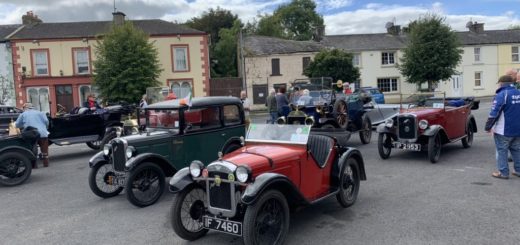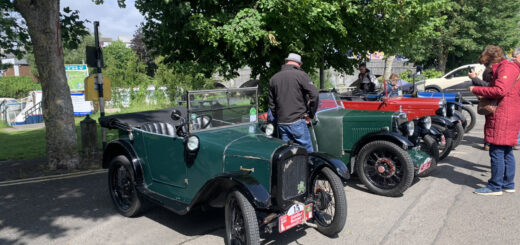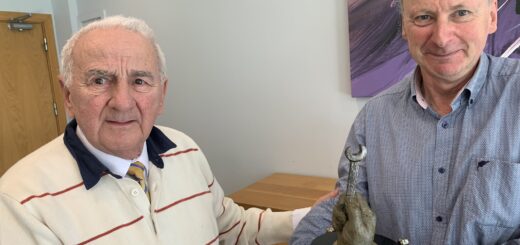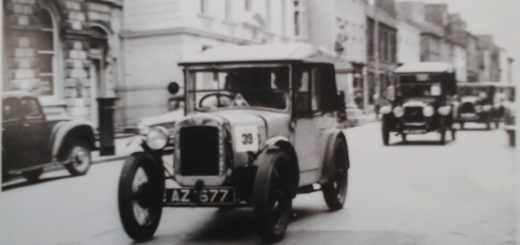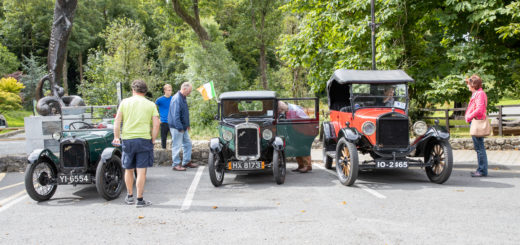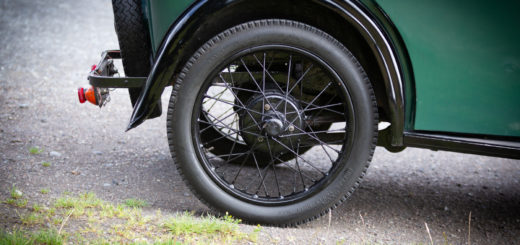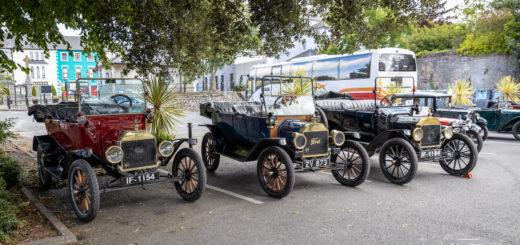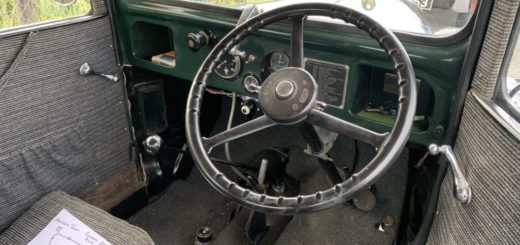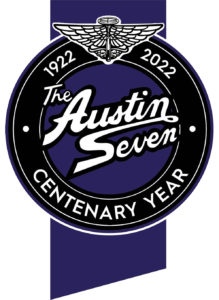Autumn Rally Sligo October 2021
Share this
Our final gathering of members for year 2021 was agreed to be an autumn run in early October to be based in Sligo and for variety and friendship with other like minded old car folks, tie up with the Connaught Club for a joint session. Notwithstanding the vagriances of weather in the North West of Ireland, the 2nd and 3rd of October was as good as any date one could chose. On Saturday 2nd, Lady Luck played her part, that whilst there were sunny spells and occasional showers that day, our group turned out to be rain dodgers enjoying spectacular scenery and blue skies.
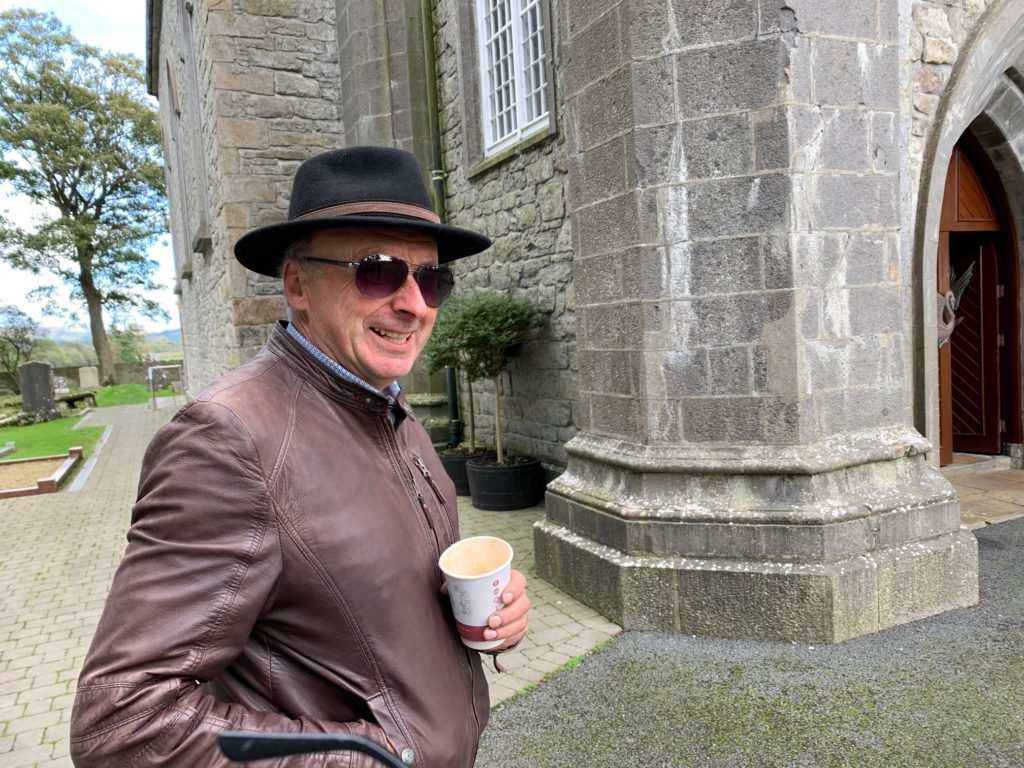
Day One – Saturday 2nd October 2021
Our Clerk of the course was Declan Grogan who provided maps for all and conducted his drivers’ briefing on time and with expertise to the assembled gathering of Seven owners, representing the three provinces of Ireland, Munster, Leinster and Connaught. By 11:15am, our group of six splendidly turned out Sevens were soon on our way, negotiating the busy and colourful streets of Sligo and heading easteards on the commencement of our run in an anti clockwise circuit taking Ben Bulben mountain as the centre point of our imaginary compass. Having travelled for less than 10 kms, with beautiful Lough Gill to our port side, so to speak, we parked up at the car park of Parker’s Castle on the lake side shore.
Parke’s Castle occupies a striking setting on the northern shores of Lough Gill in County Leitrim.
A restored castle of the early seventeenth century, it was once the home of English planter Robert Parke. There is evidence of an earlier structure on the site, a tower house once owned by Sir Brian O’Rourke, lord of West Breifne. O’Rourke, whom one English governor described as ‘the proudest man this day living on the earth’, resisted crown rule and fled Ireland, but ended up in the hands of Queen Elizabeth’s forces. He was thrown into the Tower of London, tried and finally hanged at Tyburn. Tragedy struck in 1677, when two of Parke’s children drowned on the lake. The castle then fell into disrepair. Only in the late twentieth century was it restored, using traditional Irish oak and craftsmanship.
Viewed at sunset, the castle cuts a stunning silhouette over the water. Three very kind tour guides from the Office of Public Works invited us all in to view the castle and feel free to inspect and take it all in. The restoration work was completed a few years ago and shows what can be done when one applies their ingenuity and dedication. Before the work was undertaken, the local community took advantage of the walls to shelter livestock from the cold easterly winds that scale off the adjacent lake. On cleaning up the inside yard itself, the work men were thrilled to find the foundations of a castle that had been abandoned years and years ago with the stone used to build the new structures.
Imagine this, a castle,within a castle; rather unique we would think. Photographs takes of our hosts, our people and our cars for the record, we were off again on our way through the magnificent Sligo / Leitrim countryside of mountineous a background, lake side vista and sheep grazing among the rushes and boggy farmland. One was struck by the very good blacktop surface on all the roads we travelled, making very smooth passage for our delightful cars fast approaching their centenary. We soon arrived at Mullaghmore at lunch time. Mullaghmore (Irish: An Mullach Mór, meaning ‘the great summit’)[2] is a village on the Mullaghmore Peninsula in County Sligo, Ireland.
It is a holiday destination with a skyline dominated by Ben Bulben mountain. It is in the barony of Carbury and parish of Ahamlish. Having parked up, in quick time there was a myriad of boating folk taking a particular interest in our fleet. As it happens, Saturday was the pre arranged date for the lifting of boats and pleasure craft for safe storage in anticipation of winter.
Sea going craft of all shapes and sizes, having tied up alongside the extensive harbour walls, were lifted aloft by a huge crane and placed on suitable trailers and towed off with heavy duty tractors, four wheel drive utility vehicles and other suitable forms of transport. The place was abuzz with people of varying interests, autumn holiday makers, boating enthusiasts and of course our mothly Club members. Lunch was serves at the adjoining Boatman’s Bistro Bar. It was delicious and we were all very pleased.
We cranked up again and soon we were travelling south on the Mullaghmore Peninsula on the acclaimed wild Atlantic way where the cascading waves breaking on the nearby off shore rocks were stunning. This part of Ireland is accalaimed world wide by those who seek adventure in the sport of sea surfing. Easy to imagine the thrills and excitement people have when they visit Sligo for holidays and week end marine activities.
Our journey was interrupted for a quick petrol check at a garage along the way, a few miles distant from our next stop at Drumcliff. It would be remiss of your corespondent not to elaborate on the tidings of a very famous Irishman whose final rating place was right near at our next stop. WB Yates (13 June 1865 – 28 January 1939) was an Irish poet, dramatist, prose writer and one of the foremost figures of 20th-century literature. A pillar of the Irish literary establishment, he helped to found the Abbey Theatre.
Yeats was born in Sandymount, Ireland, and educated there and in London. He was a Protestant and member of the Anglo-Irish community. He spent childhood holidays in County Sligo. In 1923, he was awarded the Nobel Prize in Literature.
Readers might be interested to know a little of his love life. In 1889, Yeats met Maud Gonne, an English-born Irish revolutionary, suffragette and actress. Yeats fell deeply in love with her but she turned down at least four marriage proposals from him; and instead married Major John MacBride. Many of Yeats’s poems are inspired by Maud Gonne or mention her. Later titled “He Wishes for the Cloths of Heaven” this poem is one of the shortest poems of Yeats comprising of only one verse of eight lines.
In it, the speaker tells his beloved that he would have spread “heavens’ embroidered cloths” under her feet if he possessed them but, as he is poor, he only has his dreams to spread under her feet and hence she should tread softly. Aedh is an Irish God of Death. Aedh appears in several works by Yeats as a pale and lovelorn man. It is thought that Aedh in this poem is Yeats, who is expressing his feelings for his muse Maud Gonne. Aedh Wishes for the Cloths of Heaven is one of the most popular short poems by W B Yeats.
Poem:
Had I the heaven’s embroidered cloths, Enwrought with golden and silver light, The blue and the dim and the dark cloths Of night and light and the half-light, I would spread the cloths under your feet: But I, being poor, have only my dreams; I have spread my dreams under your feet Tread softly because you tread on my dreams.
Isle of Innisfree is an uninhabited island within Lough Gill, in County Sligo, Ireland, where Yeats spent his summers as a child. In this short poem of three stanzas of four lines, the speaker, who is residing in an urban city, yearns to return to the peace and serenity of Innisfree. The poem is notable as being a famous work of the Irish Literary Revival movement which aimed to create distinct art and literature that was Irish in origin rather than one that adhered to the standards set by the English. Lake Isle of Innisfree was critically acclaimed when it was published. It remains one of the best known poems of Yeats with multiple references to it being made in popular culture over the years.
Poem:-
I will arise and go now, and go to Innisfree, And a small cabin build there, of clay and wattles made; Nine bean rows will I have there, a hive for the honey bee, And live alone in the bee-loud glade. And I shall have some peace there, for peace comes dropping slow, Dropping from the veils of the morning to where the cricket sings; There midnight’s all a glimmer, and noon a purple glow, And evening full of the linnet’s wings. I will arise and go now, for always night and day I hear lake water lapping with low sounds by the shore; While I stand on the roadway, or on the pavements grey, I hear it in the deep heart’s core.
What is surprising is the writing on his tombstone taken from the last line of his poem “Cast a cold eye On life, on death. Horseman, pass by!” That is the epitaph that Poet William Butler Yeats wrote for himself, and, according to his careful directions (“No marble, no conventional phrase”), it is engraved on his simple tomb in the churchyard of Drumcliff, in the poet’s native Sligo. But ever since his death in 1939, his admirers have refused to cast a cold eye on his memory
VI
Under bare Ben Bulben's head In Drumcliff churchyard Yeats is laid, An ancestor was rector there Long years ago; a church stands near, By the road an ancient Cross. No marble, no conventional phrase, On limestone quarried near the spot By his command these words are cut: Cast a cold eye On life, on death Horseman, pass by!
Enough of culture now for our friends and followers. We duly made our way back to our Rally base at the four star Sligo Southern Hotel. Declan and Nuala hosted our pre dinner reception followed by a delicious banquet in the hotel dining room, adhering to social distancing and obeying best practice in protecting one another from the dreadful COVID 19. And there it is, an account of a most enjoyable day hosted by an expert in the company of friends of the Austin Seven. Great to have an outing with friends, no mishaps, no breakdowns, just fun and enjoyment in old one marque cars.
Patrick Dwyer, founder director, presented Declan with a hand turned beech bowl especially crafted for the occasion in appreciation and as a memento of a good day out. Thank you Declan.
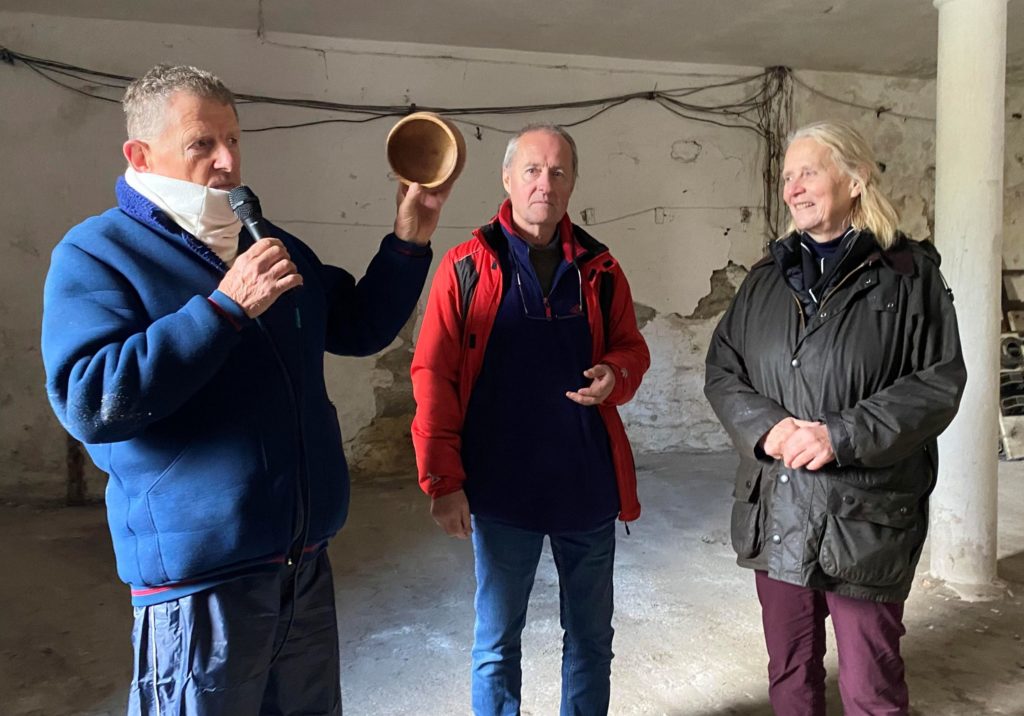
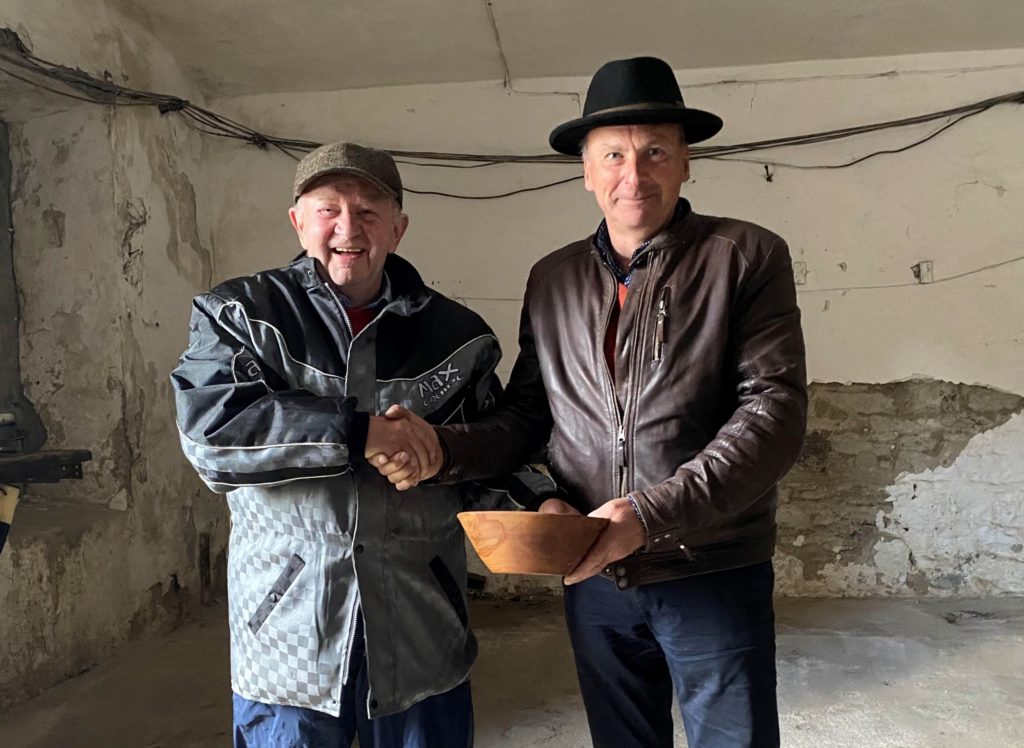
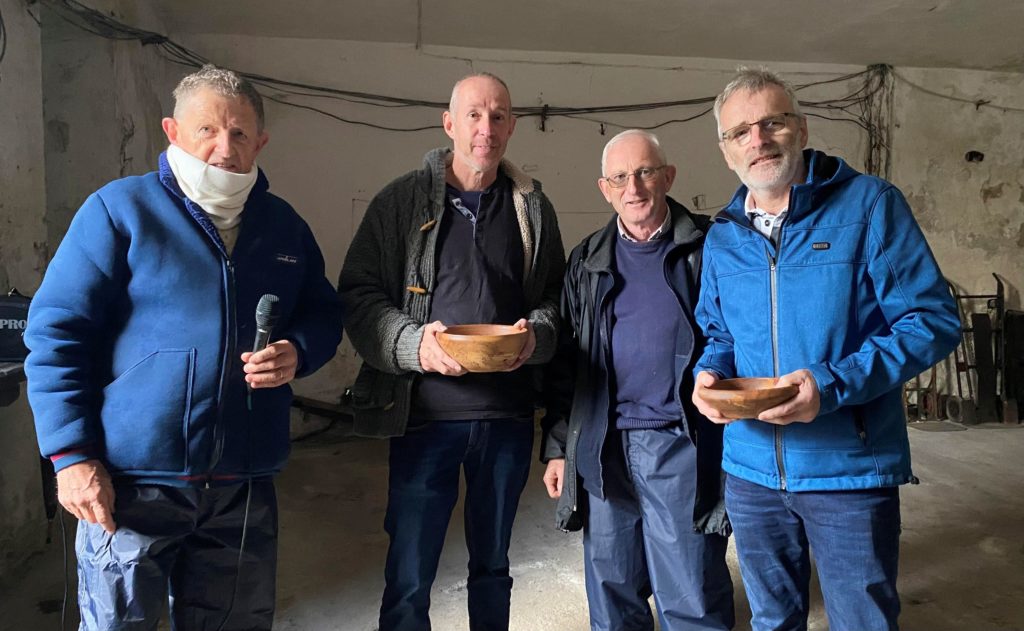
Day Two – Sunday 3rd October 2021
We were invited by Connaught Vintage and Veteran Car Club to join in with them on their own Autumn Run which really was social affair with short driving and long stops. There was an assembly of magnificent cars from across Ireland, north and south dating back to the start of the last century to which our little Sevens were dwarfed in the company of giants. One colourful Connemara gentleman commented “for such a small car, they are a fine little yoke”. Well said !
Upwards of 50 cars assembled at North West Business Park at Rathrippon about 10 kms south of Sligo on the N4 motorway that leads to Dublin. Our cars were present, to which is added a few local Sevens. We were greeted by the joint organisers Keith English and Sean O’Brien who made us feel most welcome. The venue for the morning refreshments was in the adjoining Top shop/petrol station complex where most of the attendees ran for cover to avoid the unpredictable fall of rain from time to time.
Your correspondent took time to take photographs of the cars for your enjoyment and to give readers a feel of the very happy occasion. At noon, the cavalcade of cars set off heading for Collooney on a circuitous route of about 20 kms, of rural side roads, passing alongside Lake Isle of Innisfree and other scenic spots, where we ended up in an old Flax Mill that is being restored.
Delicious sandwiches, cakes and buns together with hot tea and coffee was on offer for the gathering inside the old mill building itself. We were addressed by Ms. Wendy Lyons, an architect interested in conservation, who gave an account of the building and the valiant efforts on hand to restore it to its former glory. Wendy told us of the retting of the flax, the scutching process separating the linen strands from the foliage and the teams of people engaged in weaving right in the heart of this village.
On flax and linen generally, and for your information, to get a sense of where we were, little is known of the Sim family and the reconstruction of the Mill in 1913. Over the entrance door where we came and went, is a carved limestone plaque “Reconstructed by Alexander Sim . 1913. Maybe some other day we will return to visit and hear more of this family and it’s flax connection. The linen industry started in Sligo at the beginning of the 18th century. In 1736 the port of Sligo was one of only five harbours in Ireland designated as locations to keep records of flax production. Trading in linen took place at first in the market yard. The linen market was the centre of a large linen industry in the county.
This industry grew the flax and carried out all the processing operations until the rolls of linen were ready for sale. The linen industry gave part-time employment to a large part of the rural population. For example in 1809 a total of 5192 persons were engaged in the growing of flax. The peak year for flax production appears to have been 1817 when almost 3k acres of flax were grown in county Sligo. Trading in linen was transferred to a “Linen Hall” in Old Market Street in 1760 and continued there until a new “Linen Hall” was built on Cochran’s Mall (Toff’s Night Club) in 1799. By this time the linen industry was being described as “the chief manufacture of the county” McParlan).
In 1799 Ballymote was described as a village almost entirely inhabited by weavers and there were over 100 weavers in Ballisodare/Collooney in 1815. 1815 to 1820 was the high point of the industry and weaving was almost extinct by the time of the great famine though some spinning continued. The 1841 census lists 4,383 spinners compared with only 269 weavers. The Linen Hall closed around this time. The early decline of the linen industry was caused by the spread of factory production in the textile industry and by competition from cotton. So there you have it, a short presse on the linen industry in County Sligo.
Every one fed and watered, the opportunity presented itself to praise and give thanks to those who worked so hard and well to make our day enjoyable and safe. With sincere thanks, Chris O’Mahony, Honorary Treasurer presented Keith and Sean with hand turned bowls from a beech tree that had fallen in Cork during the storm Ophelia of three years past. In appreciation of her talk to us all on the old Flax Mill and the linen industry in Sligo, which we all found interesting, Paul Cahill presented Ms. Wendy Lyons with a 6 inch Viking Bowl, a replica of one found during the excavations of the Wood Quay construction site in Dublin a good number of years ago. As an architect interested in conservation, we hope that she will enjoy our present to her from us.
Around about 3:00 pm it was time to say goodbye and bid farewell. As the motoring season draws to a close, so too, having cranked up and started our several veteran cars we were all off in different directions homeward bound, very happy with ourselves having met up with old acquaintances and introduced to new friends who share a passion and love for our majestic cars of yesteryear.
In closing off, from our club’s perspective, it surely was a good year for us: we managed a goodly number of runs during the summer once we were permitted to so do in a successful fashion having regard for social distancing, wearing of masks and ensuring frequent hand washing. With renewed thanks to the many club members who rose to the surface to head up our events: Chris for Cahir, Declan for Callan, Laurence for Newcastle, Basil and Marion for Carlingford and Declan for Sligo. The template is set for 2022. Here’s hoping for the good times ahead.



